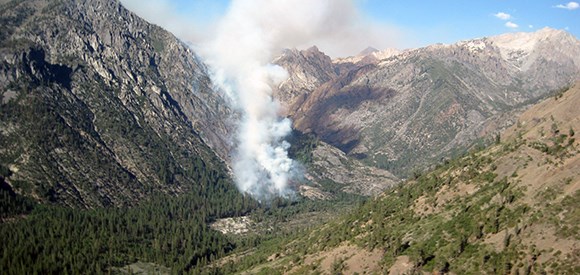Last updated: December 14, 2017
Article
Windy Peak Fire: Response Considers National Fire Situation

The Windy Peak fire was discovered during a reconnaissance flight on August 23, 2013. This lightning-caused fire was a “sleeper,” or holdover, fire from lightning storms earlier in the week. Because these storms came with rain, fires may have remained dormant for several days until conditions allowed the fire to grow.
When the fire was discovered, it was estimated at 40 acres. Although this fire was in a remote wilderness location, the parks chose to contain the fire due to drought conditions and the need for firefighting resources throughout the state and nation.
However, the response was similar in several ways to managing the fire for forest health.
-
Limited availability of firefighting resources dictated response by park firefighters only. Some of the parks’ crews were on other fires throughout the West. The parks maintain a proper level of “drawdown.” This means that adequate staff remain within the park for initial response to fire starts. However, if a fire grows, the parks can order additional firefighting resources to assist.
Regional and national coordination centers determine and prioritize where firefighters and aircraft are assigned based on need and urgency. The Windy Peak fire did not threaten life or property. The Rim fire was rapidly growing north of the parks on the Stanislaus National Forest and Yosemite National Park. Firefighting resources were needed elsewhere. -
Firefighters effectively held the fire north of the Kings River to anchor the fire. However, because of limited firefighting resources, the fire spread north and east along a series of cliff bands. Firefighters were able to use avalanche chutes and other rocky areas to contain the fire at 681 acres.
-
Excellent fire effects were observed, even though it was a drought year. Dead and down fuels were consumed, and some single and group tree torching was observed--fire behavior representative of the Sierra Nevada fire regime. This area did not have an unnatural abundance of fuels and includes rocky areas. This scarcity of fuels allowed fire to have a beneficial role in the ecosystem.
The fire management staff in Sequoia and Kings Canyon National Parks evaluate each fire, considering multiple variables, including firefighter safety, values at risk, air quality, potential benefits of a fire, and the national situation and need for firefighting resources. The response to the Windy Peak fire illustrated prudent application of this philosophy.
Contact: Deb Schweizer, fire education specialist
Email: e-mail us
Phone: (559) 565-3703
